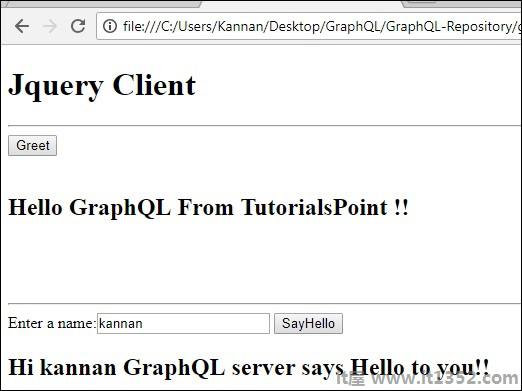Web应用程序异步发送和检索数据(在后台). AJAX允许网站在不刷新页面的情况下将内容加载到屏幕上. jQuery为AJAX功能提供了几种方法,因此更容易使用AJAX.在本章中,我们将学习如何将GraphQL与jQuery集成.
考虑使用客户端服务器体系结构的应用程序.我们可以构建一个从GraphQL服务器请求数据的前端网页.该网页将使用jQuery向GraphQL服务器进行AJAX调用.
要将GraphQL与JQuery集成,让我们检查GraphiQL请求标头并理解请求参数.
启动 hello-world 应用程序(相关说明请参阅第6章).在GraphiQL窗口中键入graphql查询{greeting}.右键单击并检查或按下铬上的(ctrl + shift + I)以转到网络选项卡,如下所示 :

从简单的 hello-world 示例中,我们可以理解 http方法使用的是 POST 的.现在在浏览器中,向下滚动到标题部分以查看请求有效负载.
点击查看代码后,将在chrome的请求有效负载部分中看到以下内容.
{"query":"{\n greeting\n}","variables":null,"operationName":null}另请注意请求URL, http://localhost:9000/graphql 应该从客户端应用程序调用.
让我们了解如何使用逐步过程将GraphQL与JQuery集成./p>
我们将学习使用以下步骤设置服务器 :
创建名为 jquery-server-app 的文件夹.从终端将目录更改为jquery-server-app.按照环境设置章节中说明的步骤3到5进行操作.
在项目文件夹 jquery-server-app 中添加schema.graphql文件并添加以下代码 :
type Query
{
greeting: String
sayHello(name:String!):String
}该文件定义了两个查询问候和 sayHello . sayHello查询接受字符串参数并返回另一个字符串. sayHello()函数的参数不为空.
在项目文件夹中创建文件resolvers.js并添加以下代码 :
const Query =
{
greeting: () => 'Hello GraphQL From TutorialsPoint !!' ,
sayHello:(root,args,context,info) => `Hi ${args.name} GraphQL server says Hello to you!!`
}
module.exports = {Query}这里,问候语和 sayHello 是两个解析器.在sayHello解析器中,传递给name参数的值可以通过args访问.要访问模块外部的解析器函数,必须使用 module.exports 导出Query对象.
创建server.js文件.请参阅环境设置章节中的步骤8.在终端中执行命令 npm start .服务器将在9000端口上启动并运行.在这里,我们使用GraphiQL作为客户端来测试应用程序.
打开浏览器并输入URL http://localhost:9000/graphiql .在编辑器中输入以下查询 :
{
greeting,
sayHello(name:"Mohtashim")
}来自服务器的响应如下所示 :
{
"data": {
"greeting": "Hello GraphQL From TutorialsPoint !!",
"sayHello": "Hi Mohtashim GraphQL server says Hello to you!!"
}
}因为我们已经设置好了服务器,现在我们将学习如何设置客户端.
首先,我们将在项目文件夹外创建一个名为 jquery-client-app 的文件夹.
我们将在jquery中创建一个客户端应用程序并调用这两个方法.以下是 index.html 文件的代码.当点击按钮 - Greet 和 SayHello 时, index.html 页面会向服务器发送请求.我们将使用$ .ajax()函数发出异步请求.
<!DOCTYPE html>
<html>
<head>
<script src = "https://ajax.googleapis.com/ajax/libs/jquery/3.3.1/jquery.min.js"></script>
<script>
$(document).ready(function() {
$("#btnSayhello").click(function() {
const name = $("#txtName").val();
console.log(name);
$("#SayhelloDiv").html('loading....');
$.ajax({url: "http://localhost:9000/graphql",
contentType: "application/json",type:'POST',
data: JSON.stringify({ query:`{
sayHello(name:"${name}")}`
}),
success: function(result) {
console.log(JSON.stringify(result))
$("#SayhelloDiv").html("<h1>"+result.data.sayHello +"</h1>");
}
});
});
$("#btnGreet").click(function() {
$("#greetingDiv").html('loading....');
//https://kannan-first-graphql-app.herokuapp.com/graphql
$.ajax({url: "http://localhost:9000/graphql",
contentType: "application/json",
type:'POST',
data: JSON.stringify({
query:`{greeting}`
}),
success: function(result) {
$("#greetingDiv").html("<h1>"+result.data.greeting+"</h1>");
}
});
});
});
</script>
</head>
<body>
<h1>Jquery Client </h1>
<hr/>
<section>
<button id = "btnGreet">Greet</button>
<br/> <br/>
<div id = "greetingDiv"> </div>
</section>
<br/> <br/> <br/>
<hr/>
<section>
Enter a name:<input id = "txtName" type = "text" value = "kannan"/>
<button id = "btnSayhello">SayHello</button>
<div id = "SayhelloDiv"> </div>
</section>
</body>
</html>在浏览器中打开此文件,然后单击按钮以查看响应.输出将在下面给出 :
